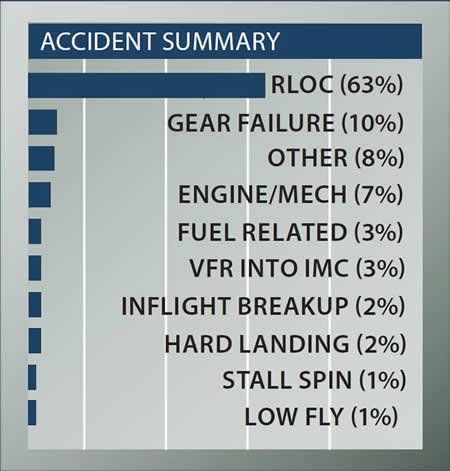With their large, comfortable cabins, the Cessna 190/195 series airplanes are delightful cross-country machines—and amazingly safe in that role. Our survey of the 100 most recent 190/195 accidents revealed an almost astonishingly low number of accidents one would expect to see in airplanes used for traveling such as engine failures, VFR into IMC crashes and fuel-related events. They totaled only 15 percent of the accidents—for flat-engine airplanes, we’d expect to see at least that many accidents from engine stoppages alone. We only saw seven engine stoppages in the 190 and 195.
Of those 15 accidents, there were two in-flight breakups, one due to pilot incapacitation and one after the owner flew his airplane into a line of thunderstorms. Only one pilot ran his airplane out of fuel, but that was because he didn’t get a fuel cap on correctly, siphoned the tank dry and didn’t believe his sagging fuel gauges. Two pilots didn’t drain the “rusty water” out of their tanks before departing and things got quiet up front.
Where things get ugly are when pilots try to land 190s and 195s—they lose control at a rate higher than any other airplane we’ve looked at in our Used Aircraft Guide accident surveys. We found that 63 percent of the accidents were runway loss of control excursions that were bad enough to tear up the airplane. We don’t know how many groundloops occurred that merely embarrassed the pilot.
Tied in with those 63 wild rides were at least 15 assertions by the pilots that one or both brakes either failed or locked up. That brings the simple pilot mishandling accident rate more in line with other tailwheel airplanes, but also indicates that brake maintenance is a matter to be taken seriously in a 190 or 195.
In addition, the airplanes have a lot of mass, so when they start to swerve, a pilot has to take corrective action immediately. The good thing is that the rudder is on a long arm, so there is a lot of control authority—the bad news is that mechanics knowledgable about 190/195 innards tell us that they often see mis-rigged landing gear which can turn a good-handling tailwheel machine into a pilot’s nightmare.
Because of the rate of landing accidents, we were surprised to see only one accident involving a blown go-around. Either 190/195 pilots are so bull-headed they won’t go around when a landing starts to go south or making a go-around has a very high rate of success.
We had to wonder about the thought process of the pilot who went around before touchdown in a stiff, direct crosswind. He flew the pattern and came down final 15 MPH faster the next time. Apparently, he didn’t remember that he was going to have to slow down during rollout and that his risk wasn’t in putting the airplane on the runway—it was keeping it there. Almost predictably, he lost it as he slowed down from a wheel landing and tore up the airplane.
There were 10 fatigue failures of gear legs or axles—a high rate, in our opinion.
We noted that one pilot flipped his airplane on rollout because, he told investigators, he had diabetic neuropathy and couldn’t tell how much force he applied to the brakes. He hadn’t had an FAA medical in years.


